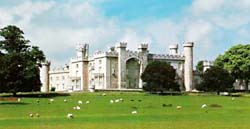
Bodelwyddan Castle, Wales
|
|
My collection of holograms has evolved over more than twenty five years involvement with the medium, the first ten years in commercial holography and the remainder as a collector and organiser of holographic exhibitions. During that time I have seen the medium develop from an optical curiosity in the hands of a few scientists and even fewer artists to a medium with global applications in the fields of packaging and security printing and increasing use in the area of display advertising, to name but a few of its guises.
|
 |
Holography the 3-Dimensional Experience
Works from the Jonathan Ross Collection
Bodelwyddan Castle, Wales
July 12 - Sept 17
Opening reception
Installation views
|
| Along the way I have accumulated an archive which documents the many and various uses of holography and a collection of work by many of the first generation of artists to work with the medium in Europe and the USA. Historic pieces from pioneer figures and substantial bodies of work by artists who have become firm friends over the years. In this exhibition I have chosen what I hope is a representative selection of holograms to challenge the widespread perception of holography as merely a novelty product or something on your credit card, and to illustrate what a versatile and delightful medium it can be in the hands of a creative artist, and the occasional inspired scientist. Like Painting and Photography, holography can be used to produce Abstract images, Still Life compositions and Portraits, but uniquely it is capable of creating animated, multi-colour three dimensional art works that can entertain and astonish the viewer and inspire memories that will last a lifetime.
Various techniques are employed in the creation of holograms.
In a classic hologram, an expanded laser beam is reflected from an object onto a fine grain photographic emulsion, coated onto a glass plate or sheet of film, and a second, undistorted, coding or reference beam is directed onto the same plate creating an interference pattern there. When it has been processed, in much the same way as the film in a camera, an expanded laser beam is directed onto the plate at the same angle as the original reference beam and a three dimensional image of the object is reconstructed, the hologram acting as a sort of complex lens bending the light into shape.
Developments in holography have allowed a white light source, such as a halogen spotlight, to reconstruct the image, making holography far more accessible, and most of the holograms in this exhibition are variations of the technique described. In most cases it is clear that the image has been recorded from a particular subject or object but occasionally artists use optically diffractive subjects and create images that essentially paintings in light.
Holographic stereograms are a hybrid of holography and photography. They make use of the principles of stereo photography in which a three-dimensional image is reconstructed from two flat images, recorded simultaneously through lenses a couple of inches apart, like the spacing of human eyes. Holographic stereograms usually incorporate many pairs of images, creating a solid and/or animated 3D image. They can be derived from photographic or computer generated sources, and by making red, green and blue exposures for each frame, a full colour image can be created. (Patrick Boyd's 'Virtual Dialogues')
Basic holograms are monochromatic in colour, the early ones being typically ,green, red or orange. Artists who were not satisfied with this have resorted to various techniques to overcome this.
John Kaufman's works, for example, demonstrate emulsion swelling techniques, whereby the hologram is chemically tuned to be sensitive to a different wavelength of light between exposures. Multiple exposures will build up a multi-colour image.
White Light transmission holograms, like Rudie Berkhout's 'Breakthrough' and Jim McIntyre's 'Science, Moths and Flies' use multiple exposure techniques to create holograms that reconstruct a rainbow coloured image at different angles, so when these are superimposed a multi-colour image is visible at the central viewing position.
Some of the holograms in this exhibition were created using equipment costing many thousands of pounds, others on inexpensive home-made set-ups in basements and garages.
Some occur through the collaboration of artists and scientists or artists and commercial facilities. Others were created in independent studios. The ingenuity of artists who have chosen holography as their medium is not to be underestimated and some of my favourite holograms were made on a shoestring budget.
As holography enters an increasingly computer-dominated era in the search for large scale, full colour, animated images I think it is refreshing to look back at some of the pioneers' work, crafted during the first flush of enthusiasm with a new medium. I hope it will appeal to a new generation as much as it did to me when I first encountered it in the late 1970s.
Jonathan Ross
July 2006
|
|
Works on Show
MARGARET BENYON
Wrapped Flowers
Cornucopia
Split Benedict
JOHN KAUFMAN
Rake
Weeping Stone
Flying Rock
Moiree Screen
DAVID PIZZANELLI
Good Morning
Arabesque
Mother & Child
MARTIN RICHARDSON
Freedom Is A Word III
Frenzy
SUSAN COWLES
The Juggler
The Seedmakers
INAKI BEGUIRISTAIN
Reflections
JON MITTON
You Will Obey
Cocaine
Testosterone
F Faces
CAROLINE PALMER
Easter
Bar Code
Diamonds and Stripes
HARRIET CASDIN-SILVER
Venus of Willendorf '91
Grater
PEARL JOHN
Kirsti
Shaman Journey
Through Childlessness 2
PATRICK BOYD
Lucy in a Tin Hat
Virtual Dialogues
Huxley's Day Out
Cows in Motion
Bop
Best Friend
Busby B
ANDREW PEPPER
Square Eclipse
Six Lines Folded
Line Addition
RUDIE BERKHOUT
Study in Light #6
Breakthrough
STEVE BENTON
Crystal Beginnings
Rind II
JO FAIRFAX
Limbic System
KEN HARRIS
Lightman
Horizon
JIM MCINTYRE
Science, Moths & Flies
JEFFREY ROBB
My Great Aunt
Water Droplet
MICHAEL WALLER-BRIDGE
Whispers
Partial Symmetries
DOMINIC WELBY
Ebb and Flow
HANS BJELKHAGEN
Russian Egg
DORIS VILA
Fire
|


